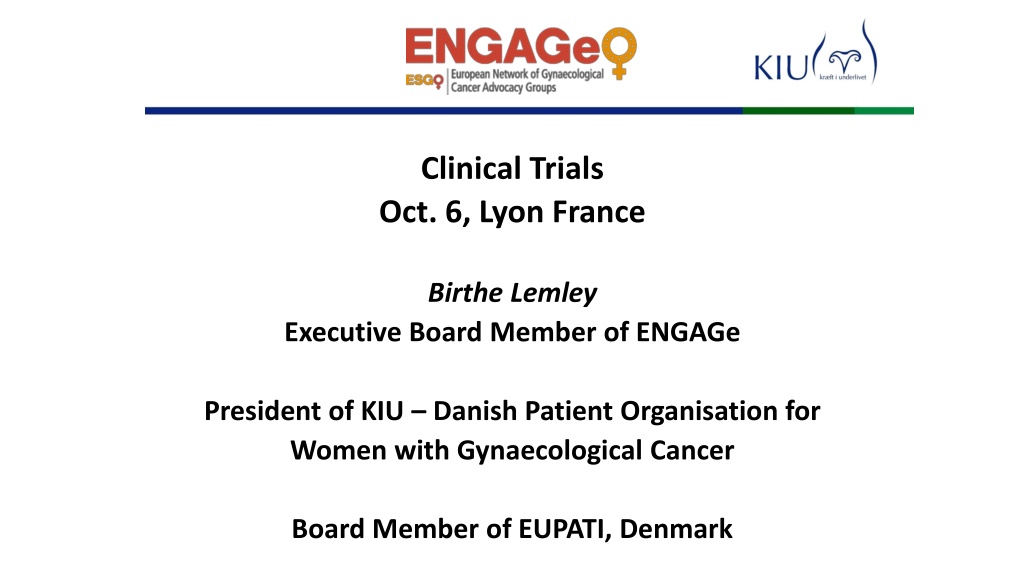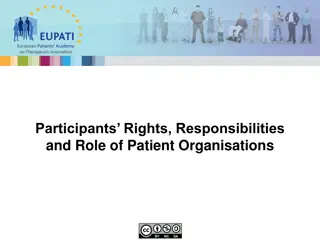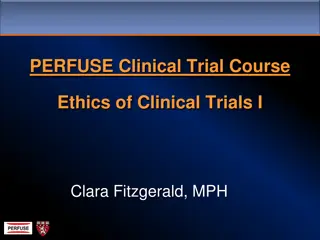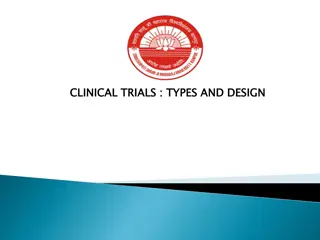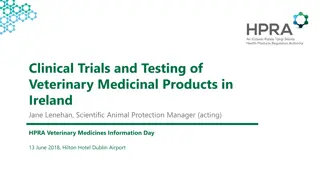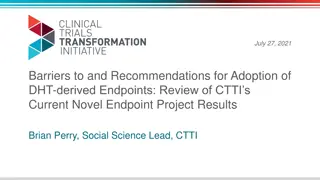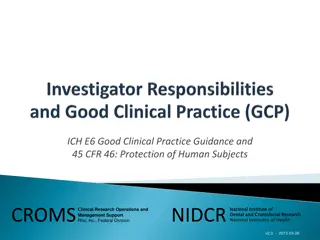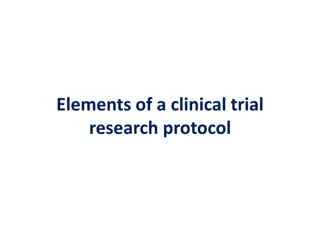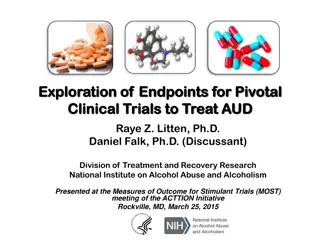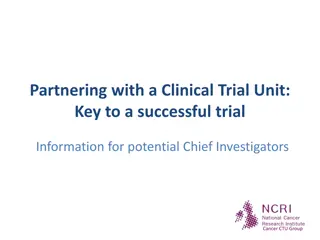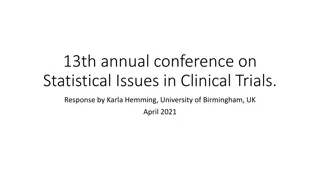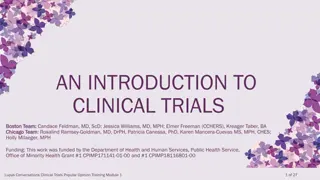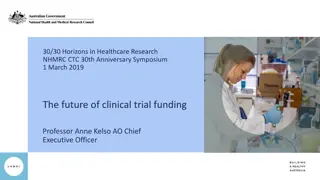Overview of Clinical Trials and Study Protocol
Clinical trials are essential for advancing medical knowledge and treatment options. They are conducted by investigators in collaboration with pharmaceutical companies, involving randomised controlled trials with phases focusing on safety, efficacy, and clinical advantages. The study protocol outlines key information such as project summary, sponsor details, rationale, and roles/responsibilities.
Download Presentation

Please find below an Image/Link to download the presentation.
The content on the website is provided AS IS for your information and personal use only. It may not be sold, licensed, or shared on other websites without obtaining consent from the author.If you encounter any issues during the download, it is possible that the publisher has removed the file from their server.
You are allowed to download the files provided on this website for personal or commercial use, subject to the condition that they are used lawfully. All files are the property of their respective owners.
The content on the website is provided AS IS for your information and personal use only. It may not be sold, licensed, or shared on other websites without obtaining consent from the author.
E N D
Presentation Transcript
Clinical Trials Oct. 6, Lyon France Birthe Lemley Executive Board Member of ENGAGe President of KIU Danish Patient Organisation for Women with Gynaecological Cancer Board Member of EUPATI, Denmark
What is a Clinical Trial? A clinical trial can be started by a pharmaceutical company or by an investigator (typicalley a doctor/professor at a hospital or other institution) If the trial is started by an investigator, there is often a collaboration with one or more pharmaceutical companies if drugs are involved in the clinical trial Usually clinical trials are international (multiple sites) meaning that hospitals from several countries are involved in the clinical trial A clinical trial can be open or blinded. If it is blinded the patient does not know which drug she is taking (the drug being tested or a comparison drug/placebo) (the doctor can also be blinded). A clinical trial is often randomised meaning that the patient is either participating in the arm with the new drug or in the arm with a comparison drug/placebo. Randomisation is not always 1:1. It can also be 2:1 or another combination.
What is a Clinical Trial? In randomised controlled trials, trial participants are randomly assigned to either treatment or control arms. The process of randomly assigning a trial participant to treatment or control arms is called randomisation . Different tools can be used to randomise (closed envelopes, computer generated sequences, random numbers). The clinical trial must be approved by an ethics committe. When a patient has accepted to participate in a trial, she is asked to sign an informed consent The patient can withdraw from the trial at any time.
What is a Clinical Trial? The 3 phases of a trial Phase I only a small number of patients are included. Purpose: establishing safety and the dosage of the drug Duration: several months Phase II Up to several hundred patients with the disease/condition. Duration: several months to 2 years Purpose: antitumor activity and side effects, also after multiple cycles in an idealized situation (patients are usually very similar) Phase III 300 to 3,000 people with the disease or condition Duration: 1 to 4 years Purpose: clinical advantages over standard treatment in daily life (efficacy and side effects)
The study protocol Outline of the content of a study protocol Project summary/abstract General information Protocol title, protocol identifying number (if any), and date. Name and address of the sponsor/funder etc. Name and title of the investigator(s) Name(s) and address(es) of the clinical laboratory(ies) and other medical and/or technical department(s) and/or institutions involved in the research Rationale & background information The Rationale specifies the reasons for conducting the research in light of current knowledge and examines benefits and harms of each intervention. Roles and responsibilities
Development of a New Drug/New Treatment Placebo Substance or treatment with no active therapeutic effect. A placebo can be made to resemble an active medication or therapy so that it functions as a control. Problems in study design with placebo Placebo as control when there is a recognized standard treatment of proven efficacy. No possibility of cross-over when the tumor doesn t respond to the first therapy. Treatment with placebo is burdensome for patients.
The Outcome of a clinical trial How to read the results of a clinical trial: Niraparib a parp inhibitor Example: Parp inhibitor Niraparib used for maintenance treatment of relapse in high grade serous ovarian cancer patients. To evaluate the efficacy of niraparib versus placebo as maintenance treatment for patients with platinum-sensitive, recurrent ovarian cancer. A randomised, placebo-controlled, phase 3 trial. Two independent cohorts on the basis of the presence or absence of germline BRCA mutation were enrolled. Patients were randomly assigned in a 2:1 ratio to receive niraparib or placebo.
Inclusion criteria: 18 years Histologically diagnosed ovarian, fallopian tube or primary peritoneal cancer High grade serous histology Received at least 2 previous courses of platinum-containing therapy Responded to last regime platinum sensitive
Exclusion criteria: Known hypersensitivity to the components of niraparib Invasive cancer other than ovarian cancer within 2 years Symptomatic uncontrolled brain metastases Pregnant or breast feeding Prior treatment with a known PARP inhibitor
Cohorts in the trial OS Overall survival PFS progression-free survival was assessed independently as follows: gBRCA cohort (patients with BRCA1/2 mutations hereditary ovarian cancer) Non-gBRCA cohort (non-hereditary BRCA mutations) HRD positive (homologous recombination DNA deficiency) HRD negative
Outcome of the Clinical Trial Results of PFS for gBRCA cohort PFS of 21 months versus 5.5 months for placebo a difference of 15.5 months (Hazard ratio: 0.27 reduced the risk of disease progression or death by 73 %) PFS for the non-gBRCA cohort PFS og 9.3 months versus 3.9 months for placebo a difference of 5.4 months (Hazard ratio: 0.45 reduced the risk of disease progression or death by 55 %) P-value = low p-value = strong evidence e.g. p>0.0001
Other important issues in a clinical trial Adverse events Haematological AEs Nausea Vomiting Constipation Fatigue Hypertension Health related Quality-of-Life Always measured according to various validated questionnaires
Why enter a clinical trial? What could be the advantages for patients to participate in a clinical trial? For you as a patient? For other patients? Has any of you every participated in a clinical trial. If yes, let us know why you decided to participate in a clinical trial?
Where do I find an overview of clinical trials? https://clinicaltrials.gov/ https://eudract.ema.europa.eu/ https://engot.esgo.org/clinical-trials/current-clinical-trials/ Usually a local overview in each country
